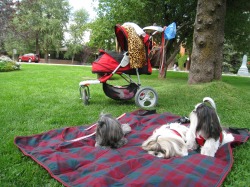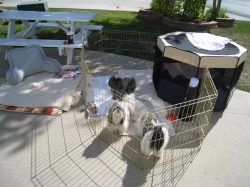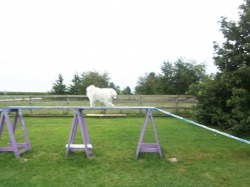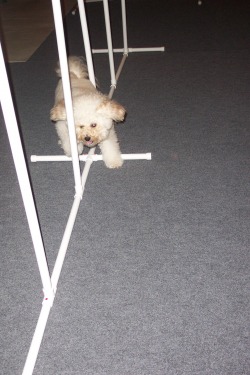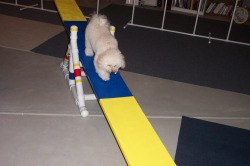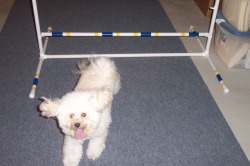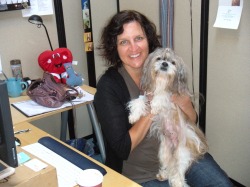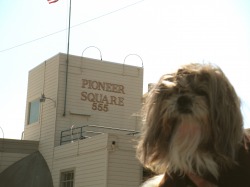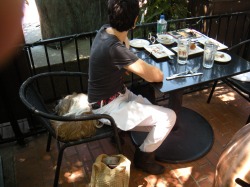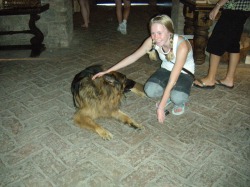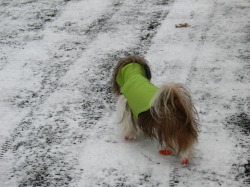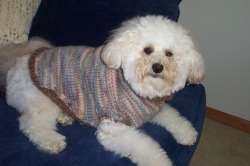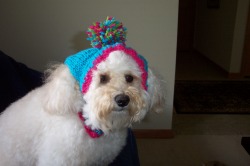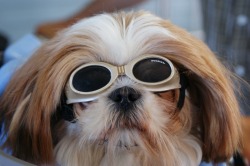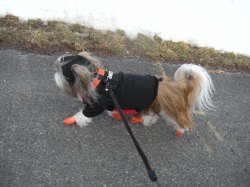
Some training advisors for large dogs that need to build up muscle mass (hmmmmm???) advise walking your dog in a weighted vest. (The dog, not yourself.) Cesar Milan has allegedly recommended weight training vests or backpacks for high energy dogs whose owners think the dogs need to calm down. Most authorities suggest the dogs begin with an empty vest and build up to 20% body weight. Hardly any authorities want dogs to start this activity before 2 years old.
The possibilities for abuse of the weighted vests are huge. Only a limited number of dogs compete by pulling weights in canine competitions. Skijorning and dog sledding are relatively rare and localized. Obviously, building excessive strength in a large dog that does not compete suggests dubious activities and bloated egos. But most of the weighted vests are used by dog owners who feel their dog has far too much energy- or at least more energy than the owner is willing to muster for walks and trips to the dog park. The weighted vests are said to calm dogs down.
Let me ask you… when you have to carry your brief case, a backpack and two bags of groceries for more than 2 city blocks, how calm does it make you feel? How much scenery do you see? Does carrying heavy weights make you want to walk further? Or do you begin to long for Sherpas?
Since the weights are not recommended for puppies under 2 years old, the weighted vests appear just at the point that most dogs are becoming less frenetic and more stable in energy level and output. This suggests that the weighted vests may not be so much about helping a dog stop leaping about, as for helping an unwilling owner walk less distance and commit less time to dog walks.
Considering how much every single dog I have ever met loves to take a walk, the use of the weighted vests to fatigue a healthy and perky young adult dog seems to be the lazy choice that takes away the best part of a dog’s day. And guess what, the lazy choice takes away one of the best parts of any dog owner’s day… taking a stroll in the fresh air with a pet.
So what do you think readers? Maybe the peppy dog and I are wrong… tell us about it.

Probably, but not as much as New York or Paris- the most dog oriented towns in the world. But never mind… back to Seattle.
The attitude is dog positive for pets in Seattle, but it’s a dog rugged attitude as well. Seattle styles itself to be about the great outdoors and every other downtown barista and polar fleece vendor will make it very clear that his or her real life begins on Mt. Rainier, generally around 13,00 ft. Dogs, however, are trotting about everywhere, especially between 6 and 8 a.m. and 5 and 7 p.m., indicating that every other person in Seattle has a job and a dog… well almost. And dogs can trot all over Mt. Ranier too, which I suppose Raja will want to do next time he’s out there just to bracket this blog post. (Remember when we were complaining that dogs couldn’t go to Muir Woods in Northern California? The only stipulation for Mt Ranier is that dogs need to be on a 6 foot lead. And this may seem restrictive, but not when you think about the native population of wolves, bears and cougars in Washington State’s wild lands.)
For the downtown tourist, Seattle tourism offers a waterfront esplanade of gift shops, fish markets, and restaurants with evocative views of the Puget Sound- a fascinating coastal resource for the Seattle area. Stroll your doggy throughout. A free underground train links much of the downtown area and connects to other train lines to further points. Seattle’s architecture is pretty cool… notice the walrus bosses on a downtown apartment building. (Your dog may not care about this either way.) Raja found a touristical shop he loved- but he’s obsessed with stuffed animals. The plan of the downtown coastal vendor promenade is to serve both residents and tourists alike, although the recession has the area unraveling a little. Go there and buy something, OK? Also visit the International District- which is about Asia in the Pacific Northwest. Remember that the coastal northwest was settled with Asian residents and the cultural expression is very different from that of NYC’s Chinatown.
One retail place we liked was the EMS flagship store with its own mountain bike trail and mock Himalayan trekking paths to try hiking boots. What we didn’t like was the restrictive and somewhat prissy “Only Service Animals” sign on the door. C’mon, you’re pitching a wilderness lifestyle here and nobody brings a badly behaved dog shopping. It just does not happen because it’s not practical. But…. naturally we ignored the signage and everything went just fine for Raja.
Happy travels, happy trekking, happy Pacific Northwest!
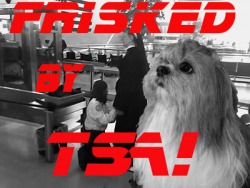
Yep that’s the story. Just when we thought the changes in security would affect pet travel slowly, Raja got frisked by a TSA worker in Seattle, Washington. And, nooo, it was not a friendly pat down- a guy with a sense of humor on the job who really wanted to pat the puppy.
So here’s how it went down: The traffic was very light. There was a ratio of about 20 TSA workers to 4 travelers when we went through security for a United Airlines flight from Seattle to Portland in the last week of January 2010. I helped Raja out of his airline travel bag so it could travel through the X-Ray machine while I carried Raja through the metal detectors. As we passed through, the TSA employee held up his hand for us to stop. He asked if Raja bites and if he could examine him. Raja doesn’t bite, but he’s never been given the once over by a total stranger in that way with no introductions and no friendly words. He told me to hold him out at arms’ length and then he passed his gloved hands around his neck and head, under his legs and belly and through the fur on his back.
OK, that was it… not too rough and pretty speedy, but 100% unexpected. Later I asked an idle TSA employee who had watched the scenario if this dog frisking was new. She admitted that it was totally new to her, but since the TSA employees had been asked to “step up their vigilance” and had been specifically requested to “do unexpected things” it did not surprise her.
How do I feel about dog frisking? About as enthusiastic as I feel about any of the processes of airline security. It’s not any fun, but I comply.
How does Raja feel? He’s not thinking about it now, but it creeped him out. Since he’s a small globe trotting dog, his training asks him to be both friendly and wary. Although naturally inclined to be sociable, he needs to resist being picked up by strangers because he’s no Doberman.
What’s the message for canine flyers and their people? Just as the show dogs stand quietly while the judge “frisks” them to check their conformance, all dog flyers should learn to stay calm if a TSA employee decides to do something “unexpected.”
Challenges, challenges, challenges… Mikey Hicks, Raja knows how you feel!


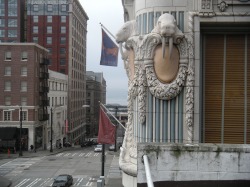



 RSS Feed
RSS Feed

